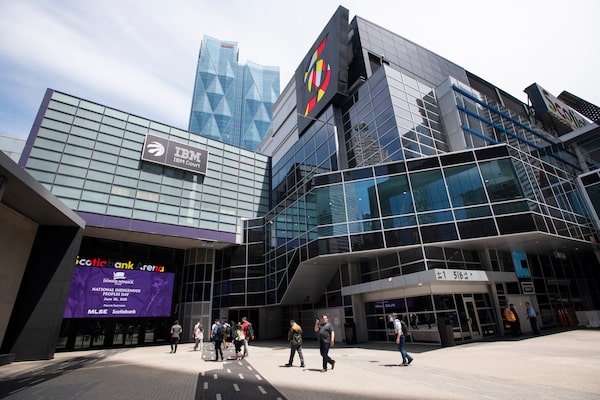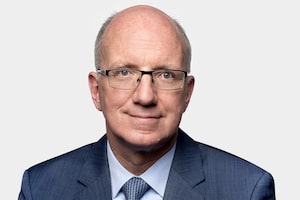
The exterior of Scotiabank Arena in downtown Toronto on June 22.Fred Lum/The Globe and Mail
Toronto sports czar Larry Tanenbaum plans to sell a stake in the parent company of hockey’s Toronto Maple Leafs and basketball’s Toronto Raptors to the Ontario Municipal Employees Retirement System pension plan for $400-million, a transaction that values the sports business at $8-billion.
Mr. Tanenbaum, 78, agreed to sell OMERS a 20-per-cent stake in the family-controlled holding company Kilmer Sports Inc. as part of his estate planning, according to four sources familiar with the transaction. The Globe and Mail is not identifying the sources because they are not authorized to speak for the companies.
Kilmer Sports owns a 25-per-cent stake in Maple Leaf Sports & Entertainment (MLSE), parent to Toronto’s pro hockey, basketball, soccer and Canadian Football League (CFL) teams. Kilmer Sport’s partners in MLSE are Bell Canada parent BCE Inc. and Rogers Communications Inc., which evenly split the remaining 75 per cent.
On Wednesday, Mr. Tanenbaum notified sports league officials of his plans, along with Rogers and Bell, in keeping with his contractual obligations. Four leagues – the National Basketball Association (NBA), National Hockey League (NHL), CFL and Major League Soccer (MLS) – and the telecom companies need to approve the transaction.
Sources said all of these parties are expected to sign off on the potential sale to OMERS, as it sets a new high watermark on sports franchise valuations.
Mr. Tanenbaum and a spokesperson for OMERS declined to comment, as did spokespeople for Bell and Rogers.
The Globe’s business and investing quiz: Week ending June 23
There is precedent for an institutional investor such as OMERS owning pro sports franchises, as well as real estate such as Toronto’s Scotiabank Arena, home to the hockey and basketball teams. MLSE was previously controlled by the Ontario Teachers’ Pension Plan. In 2012, the pension fund sold its holding to Rogers and Bell for $1.32-billion, and made a significant profit.
Based on OMERS’ proposed investment, Bell and Rogers have tripled the value of their investments in MLSE to approximately $1.5-billion each since 2012, according to a a report on Thursday from analyst Tim Casey at BMO Capital Markets.
Rogers and Bell each have the right to acquire Mr. Tanenbaum’s holding in MLSE in about three years’ time, according to sources. They said the OMERS transaction sets a floor value for any future transaction with Mr. Tanenbaum, who is chairman of MLSE.
The telecom companies will also have the right to acquire the MLSE stake that OMERS will own through Kilmer Sports, sources said. Mr. Casey expects Bell and Rogers will both want to exercise that option. He said: “We find it difficult to contemplate a scenario where either BCE or Rogers would allow the other party to own a senior equity position or obtain a path to control.”
OMERS could also increase its ownership over time by purchasing a larger stake in Kilmer Sports, sources said. The pension plan invests on behalf of approximately 600,000 Ontario public-service workers, including nurses, firefighters and police officers, and is one of the world’s largest fund managers, with $124-billion in assets.
OMERS is buying into Kilmer Sports at a time when professional leagues are loosening rules around team ownership by institutional investors, rather than wealthy individuals. In a recent report, analysts at Morgan Stanley said: “We see sports assets as among the most attractive compounders of value.”
The investment bank said pro sports franchises are benefitting from three “self-reinforcing” value drivers: rising consumer engagement due in part to sports betting; global competition for distribution rights; and scarcity of franchises. “Nothing is AI-proof, but live sports may come close,” the report added.
Over the past five years, pro sports teams saw average annual revenues from sponsorships rise 13.2 per cent, media rights increase 6.7 per cent and ticket prices go up by 4.2 per cent, according to Morgan Stanley. With more money coming in from fans and broadcasters, the value of franchises increased 14 per cent annually.
In recent months, NHL and NBA franchises have changed hands for record amounts. The NBA’s Phoenix Suns sold for US$4-billion in December, while the NHL’s Ottawa Senators fetched approximately US$950-million when transport billionaire Michael Andlauer purchased the team earlier this month.
Mr. Tanenbaum’s family roots are in the steel business, and the former student manager of Cornell University’s hockey team became a billionaire by successfully expanding into sectors such as paving, cable television and bottling Coca-Cola.
In 1996, Mr. Tanenbaum purchased a 12.5-per-cent stake in the Maple Leafs for $21-million from grocery store owner Steve Stavro, then helped arrange a deal with the Raptors two years later, with both teams moving into what’s now Scotiabank Arena. On his watch as chairman of MLSE, Toronto teams have won basketball, soccer and football championships; a Stanley Cup for the Maple Leafs remains elusive.
What MLSE owns
MLSE owns major Canadian professional and development sports teams and owns or operates their playing and practice facilities, including:
- Toronto Maple Leafs (National Hockey League)
- Toronto Raptors (National Basketball Association)
- Toronto FC (Major League Soccer)
- Toronto Argonauts (Canadian Football League)
- Toronto Marlies (American Hockey League)
- Raptors 905 (NBA G League)
- Toronto FC II (MLS NEXT Pro league)
- Scotiabank Arena, Toronto
- BMO Field, Toronto
- Coca-Cola Coliseum, Toronto
- Ford Performance Centre, Toronto
- BMO Training Ground, Toronto
- OVO Athletic Centre, Toronto
 Andrew Willis
Andrew Willis James Bradshaw
James Bradshaw Alexandra Posadzki
Alexandra Posadzki